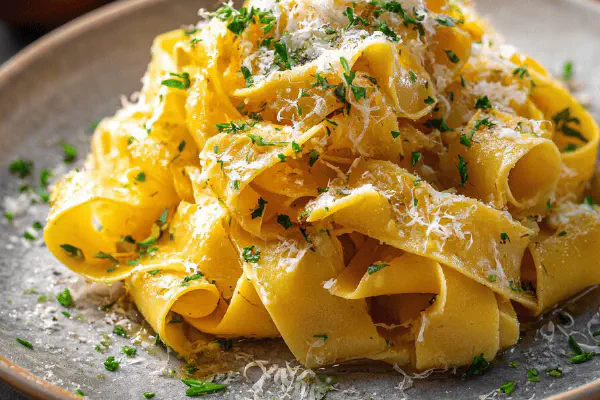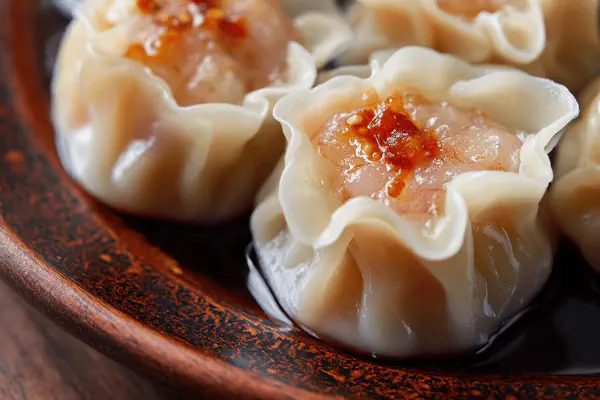Featured Recipe
Translucent Dim Sum Dough

By Kate
"
Starch-based dough for dim sum wrappers made from modified wheat starch and tapioca starch. Salt for balance. Hot water hydrates starch, triggers gelatinization for pliability. Vegetable shortening adds elasticity and prevents drying. Dough shaped into logs, sliced, pressed thin. Use warm, immediate filling needed to keep pliant. Versatile wrapper base for steamed dumplings, wontons. Simple, adaptable starch dough; gluten-free option by starch swap. Key sensory cues: dough turns shiny, supple, no cracks when pressed thin. Quick hands avoid cooling and cracking before filling.
"
Prep:
12 min
Cook:
10 min
Total:
22 min
Serves:
10
dim sum
dough
wrappers
Chinese
starch
Introduction
Quick starch dough with a difference. Blending potato and tapioca starch changes texture; potato starch adds silkiness, tapioca gives chew and stretch. Hot water isn’t just to soften - it gelatinizes starch granules, turning brittle powder into elastic dough ready for folding and shaping. Salt controls flavor, and fat’s critical: seals surface, keeps stiffness at bay. The dough’s fragile — get the timing. Roll while still warm. Shape fast before drying ruins your work. Ideal wrappers break midway balance — too thick dulls translucence and cooking, too thin tears instantly. Practical, forgiving if you watch lack of cracks, sheen. Fails when cold or over-starch dusted. Listen: dough whispers readiness via smooth touch and faint translucency. Fill right away. Not a grab-and-go dough. Technique, temperature, timing all handshake in success.
Ingredients
About the ingredients
Potato starch is a slick replacement for wheat starch here; silkier and holds steam better but fragile. Tapioca adds stretch, avoids snapping, but too much makes dough gummy and sticky. Balance both. Salt straightforward, not just taste-changer - controls starch hydration rate to improve texture. Hot water essential to activate starch granules; lukewarm water creates crumbly dough. For fat, vegetable shortening or neutral oil preferred. It lubricates without flavor drama, keeps wrappers pliable longer. Avoid cold dough — leads to cracking during rolling. Dust surface with starch sparingly — overdoing makes dough dry and tears easily. Holding dough wrapped in damp cloth during shaping prevents crust formation. Time dough prep to match filling readiness; far too often dough cools, hardens, ruins pliability. If dough cools too fast, brief reheating in microwave or bowl over warm water resets flexibility. Caution: excess water or starch traps dough between sticky and brittle landscape.
Method
===
- Mix potato and tapioca starch with salt in heatproof bowl. Gradually pour boiling water, stir vigorously with wooden spoon to hydrate starch evenly. Dough will clump, then smooth out. Let stand 1 minute to cool slightly but remain warm.
- Add vegetable oil, knead dough inside bowl until fully incorporated and smooth, about 2-3 minutes by hand. Dough should feel soft, elastic, not sticky. Too dry? Add tiny splash warm water; too wet? Dust starch lightly.
- Divide dough in half on lightly dusted surface. Roll into logs 3 cm diameter, dust if sticky. Cut into 2.5 cm thick segments. Shape each into tight balls, ensure no cracks visible.
- Use back of lightly oiled spatula or rolling pin to press each ball into thin rounds approx 6-7 cm diameter. Press gently but firmly; dough starts translucent and shiny when right thickness. Dough should not tear or stick. Dust with starch if needed to separate layers.
- Fill immediately with desired filling to avoid drying and cracking. Wrapper handles warm best. If left to cool, wrap damp cloth or plastic to prevent hardening. Store wrapped dough refrigerated for max few hours, rewarm before use.
- Steam or boil filled dim sum promptly to maintain wrapper softness and translucency.
Technique Tips
Start mixing starch and salt dry first to ensure even flavor distribution. Gradual addition of boiling water prevents lumps and fosters uniform gelatinization. Vigorous stirring stimulates starch granules expanding — key phase to observe: clumps form then smooth out — visual and tactile cues confirm hydration success. Resting time short — substrate still hot for kneading. Kneading fuses fat, water, starch into elastic mass — hands dusted lightly with starch avoid sticking without drying dough. Rolling segment diameter matters, thicker logs won’t roll thin quickly — stay consistent for even cooking. Slice with sharp knife to avoid ragged edges that snag and tear. Press dough balls with spatula’s back using slight pressure — it forces starch chains to spread and align, contributing to final texture. Too much pressure tears; too little, dough too thick to be translucent. Dusting during rolling is safeguard against sticking but minimized dust prevents tough wrappers. Wrappers used immediately. Delayed filling causes dry brittle edges, cracking risks, and softened wrappers break during cooking. If dough rests, wrap tightly in plastic or damp towel to hold humidity. For filler prep, get everything ready before shaping dough to prevent loss of warmth and flexibility. Complete process usually within 20 minutes; delay risks dough quality drop.
Chef's Notes
- 💡 Use potato and tapioca starch. Adjust ratios. More potato increases silkiness. But balance it. Too much tapioca? Gummy dough. Not enough? It tears. Starch science.
- 💡 Hot water is key. Boiling temperatures hydrate, gelatinize. Watch that transformation. Mix vigorously. Clumps first, then smooth. Don't rush that. If dough cools? Risk cracks while rolling.
- 💡 Kneading matters; don’t skip it. It's fusion. 2-3 minutes, till elastic, soft. Check texture. Stickiness? Tiny splash of warm water. Too dry? Dust lightly with starch.
- 💡 Rolling out? Focus on thickness. 6-7 cm rounds, not too thick. Check shine and translucency. If tearing, pressure is off. Too much? Tear. Too little? Not thin enough.
- 💡 Fill right away, don’t cool too long. Wrapper becomes brittle. If too late, wrap to trap warmth. Prevents hardening. Rewarm briefly if needed, in microwave or warm water.
Kitchen Wisdom
What if dough cracks?
Check water temp; boiling is a must. Cold or over-dusted? Adds trouble. If cracks appear, move fast. Keep working dough warm.
Can I store the dough?
Yes, but wrap tightly. Plastic or a damp cloth helps. Refrigerate, but use soon. Best within hours. Avoid too much air exposure.
What to do if wrappers stick?
Dust with starch before pressing. But limit it. Overdoing leads to tough texture. Or use lightly oiled spatula during shaping.
How to know when it's cooked?
Steam or boil as soon as filled. Look for translucent quality. If dull, that’s overcooked. Check for firmness. Keep an eye.



